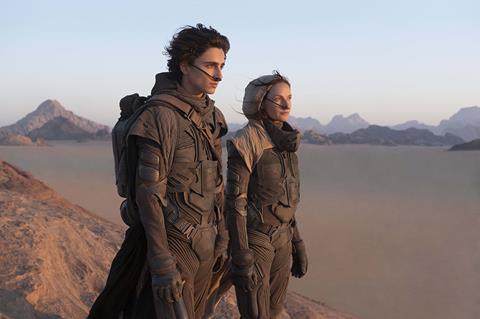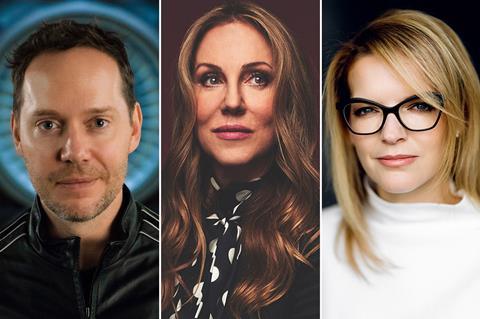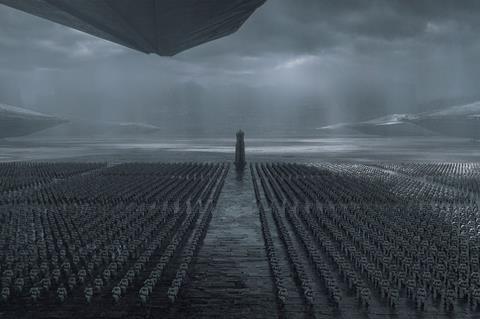Mounting Frank Herbert’s Dune for the big screen required scope, scale — and two whole movies. Screen talks to producer Mary Parent, screenwriter Jon Spaihts and executive producer Tanya Lapointe about the making of a modern sci-fi classic.

Set mainly on the harsh desert planet of Arrakis, Frank Herbert’s 1965 science-fiction novel Dune has proved irresistible to filmmakers, both as source material or, simply, inspiration. And despite being adapted twice before, by David Lynch in 1984 and the Sci-Fi Channel in 2000, Hollywood found the lure of Herbert’s thematically rich, imaginative world — with its warring houses, interplanetary travel, drug-fuelled hallucinations, giant sandworms, messiah figure and environmental message — hard to shake, with Paramount announcing a new version in 2008, first with Peter Berg, then Pierre Morel slated to direct. Neither came to pass.
Then, in 2013, when the studio decided not to renew its option, Godzilla producer and former studio executive Mary Parent, who had been tracking the project for some time, swooped in with fellow producer Cale Boyter. They brokered a deal for film and TV rights between the Herbert estate and Legendary Entertainment, little realising that three years later she would join Legendary as chairman of world production, with the Dune deal yet to be finalised.
“When I arrived, the rights were still being figured out,” Parent recalls. “As the movie gods would have it, the fact I ended up here allowed us to quickly get the rights sewn up. Rather than having to constantly follow up from the outside, we were able to jump in directly and accelerate that process.”
The movie gods were also looking out for Parent when, in September 2016, she read an interview with Arrival director Denis Villeneuve in which he called Dune his dream project. “Which has never happened to me before, will likely never happen again,” she says. “Part of what makes Dune unique is it works on two levels. On one hand, it’s a very intimate, almost family drama. On another, it’s this giant cinematic epic. There were filmmakers who could do the epic visuals. There were filmmakers who could do the intimate character story. But when you start to look at who can do both, the list is very small. I’ve loved all of Denis’s films. But I was blown away by what he did with Arrival and how real that felt — because one of the many challenges of Dune was to make it feel very real.”
With Villeneuve onboard, and Warner Bros providing 20% of the film’s budget — said to be in the region of $165m — as well as worldwide distribution through Legendary’s first-look deal with the studio, the question then became: how do you best tell such a rich, dense, complex and sprawling story as Dune? Should it be one film, as David Lynch had attempted, or two, as Warners had with Stephen King’s doorstopper novel It, which was split and released two years apart?
The task of adapting Herbert’s book into a screenplay went first to Eric Roth, Oscar-winning writer of Forrest Gump who had done a polish on Arrival, and who attempted to wrestle the 700-page story into one film. “I wrote a big, fat, pretty creative, very brave draft, which started out with the creation of the planet Dune as if it was Genesis,” reveals Roth.
Alas, it was far too costly. And so Villeneuve took a stab, paring back Roth’s 220 pages to a more manageable 119 before bringing on Jon Spaihts to ground it. “I have heard the tales of Eric’s biblical draft, [but] I’ve never seen it,” says Spaihts whose credits include Passengers and Prometheus. “What I saw was Denis’s edit of that, attempting to impose order and rein in the giant creative vision Eric had launched us with. You could see a bit of the quilt of their two imaginations, pieces that were clearly Eric’s visionary stuff and other things that were Denis’s visual thinking and storytelling.
“Not surprisingly, there was a certain unevenness to it, but a ton of great ideas and invention. I tore the book apart and did a clean adaptation. Then I took Denis’s draft and my own and synthesised them, preserving every element of clear, visual creativity where I could see Denis was filmmaking in his head as he wrote.”
Double feature

By this stage, Villeneuve had decided to split the book into two. “Two movies was a minimum,” notes Spaihts who, like Villeneuve, is a huge fan of the source material, having first read it when he was 12 or 13. “Of course, that gives rise to a host of new problems in terms of creating arc and endpoint, when you’re adapting half of a book.”
There were, he says, two obvious breaks for bisecting the novel. “The first, and more tantalising at a glance, is a time-jump in the book where the action is interrupted and you return several years later.” But they couldn’t make that work, and opted to end it earlier, at the point where the story’s central character, Paul Atreides (played by Timothée Chalamet), leaves behind his old life, goes into the desert and joins the Fremen, the native nomads of Arrakis.
Even more of a challenge was the fact that Dune is “a profoundly interior work”, explains Spaihts. “For all that it could be classed as space opera, an enormous amount is one or two people talking in a room or a single character thinking. Many of the most dramatic moments of the film, drawn directly from the book, are scenes in which a character is perfectly still, and does nothing.” Rather than rely on excessive voiceover, which marred Lynch’s version, Spaihts and Villeneuve looked for “little beats of action that could stand for and represent those interior monologues, so the audience gets the richness of the book”.
As well as swathes of internal deliberation, the novel takes an almost Shakespearian approach to action, leaving much off stage, for the reader’s imagination to fill in. “Herbert was so much more interested in the interplay of ideas than physical action,” says Spaihts. “When the Harkonnens invade, the Atreides go to bed and wake up and they’re captive. All of those create opportunities for Denis to visually create the world and drag that stuff on stage.”
Villeneuve and Spaihts were also keen to expand the female roles, notably Paul’s pregnant mother Lady Jessica, played by Rebecca Ferguson, a member of the mystical sect known as the Bene Gesserit, and Chani, played by Zendaya, a Fremen warrior who initially appears to Paul in his dreams. “We felt in Jessica there was a kind of co-protagonist [to Paul], especially in the first half of the novel, and a good adaptation would give her that magnitude, both in screen-time and dramatic importance,” says Spaihts. “We also felt there was room to look for [even] more female participation, because there are ways in which Dune was very progressive for its time — but its time was the ’60s.” One way was to gender-flip the character of planetologist Dr Liet-Kynes who, in Herbert’s earliest drafts, was Dune’s protagonist, not Paul, and is played by Sharon Duncan-Brewster.
The shoot

The production filmed for 85 days in spring and summer 2019, at Budapest’s Origo Studios, where Villeneuve made Blade Runner 2049, as well as on location in Jordan, Abu Dhabi and Norway. In Abu Dhabi, recalls executive producer Tanya Lapointe, “it was 52 degrees centigrade outside, so we couldn’t shoot beyond 9am. We would wake in the middle of the night, be out for sunrise, sleep during the day, go back for sunset.”
When it came to designing his Dune, Villeneuve returned to the book for inspiration. Or rather his memory of the book. “Every piece of visual world-building is thematic, is conceptual, is character work,” says Spaihts. “Denis created a desert that was not pretty, but a place of austere harshness. He created battleships that were not Flash Gordon rockets, but massive, brutalist engines of war. All of Denis’s epic world-building frames the plight of the characters, makes them more vulnerable, more solitary, and casts their struggles into sharper relief.”
The sets — by Blade Runner 2049 production designer Patrice Vermette — were gigantic, reflecting Villeneuve’s desire to immerse the characters in the world, as well as his aversion to green-screen filmmaking, preferring to do as much in-camera as possible. “We didn’t do a lot of set extensions and visual effects,” says Parent. “Sets were built. They were huge. It felt like old Hollywood. Going to Budapest allowed us to do that. It would have been challenging in other places, financially.”
“For Denis, it’s all about the experience of being in a space,” says Lapointe. “He’s said over the years, he’s allergic to green-screen but, in truth, he’s looking for a human reaction to these environments. They needed to be so big for the humans to feel so small. And when these same characters are out in the desert, they’re also overpowered by the space.”
Indeed, cinematographer Greig Fraser (Rogue One: A Star Wars Story) filmed in 2.35:1 and Imax to accentuate the contrast between worlds. “When we got to Arrakis, the Imax format helped emphasise the space and the feeling of being lost in these incredible landscapes,” adds Lapointe.
Originally set for release in December 2020, Dune, like so many movies, was delayed due to the pandemic. “It gave us more time to ponder where are we going with the story. I mean, we had a good idea, but more time is so valuable in thinking things through,” says Lapointe. “It was unfortunate the pandemic happened, but it was a benefit for the film.”
After premiering at Venice in September 2021, Dune opened in US cinemas on October 21 and on Warner’s streaming service HBO Max, the latter to the consternation of Villeneuve who penned an open letter expressing his anger. “It was really about communication,” says Parent of his concerns, who adds that waiting out 2021, in which Warner Bros was committed to the simultaneous release of all its titles on HBO Max, did not feel like an option. “We had waited a year to come out and waiting another year felt challenging. Thankfully people felt this was a cinematic event and went to theatres. It was made for the big screen.”
Second coming
With a global cinema gross of $399m at press time, Dune has proved a commercial and critical hit, and has earned 11 Bafta and 10 Oscar nominations, including respectively best film and best picture. Dune: Part Two was soon announced, along with a 2023 release date, although Parent says it has not yet been officially greenlit. “We’re in early prep but everything feels very on-track.”
Villeneuve and Spaihts are already at work on the script. “Denis and I just did a very intensive week-plus of daily Zoom calls in which we synchronised our minds around the structure and outline in very fine detail. I’m working on that draft now,” says Spaihts. “He’s got a very clear vision for what he wants to do in the second film. Striking a fine balance in terms of honouring and hewing to the original material, but also deepening and broadening it in a way that’s necessary to bring it into our present. The second half of the novel makes strange leaps, lets remarkably important events happen offstage, and challenges the reader to keep up. That presents intrinsic challenges to adaptation. Figuring out how to balance those without clogging the film with exposition or incident is part of the puzzle. And doing it all at an achievable scale.”
Further ahead, Villeneuve has stated he would like to adapt Herbert’s Dune Messiah into a movie to complete the trilogy, while Spaihts, who had previously been working on a Dune TV show about the Bene Gesserit, has now been charged with creating an expanded Dune cinematic universe. “Both using the other books and the very deep material of the appendix to Dune, which is many pages long and contains rich story seeds, branching off in all directions.”

























No comments yet